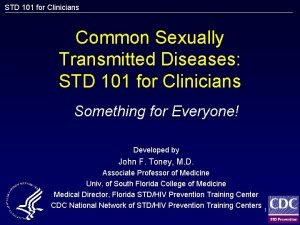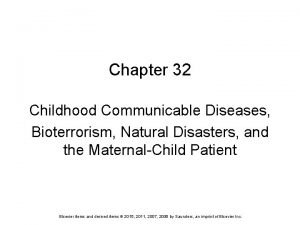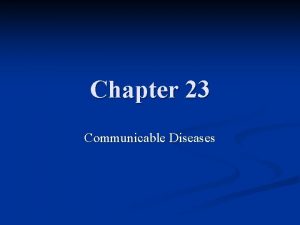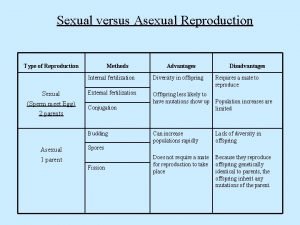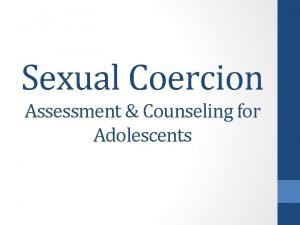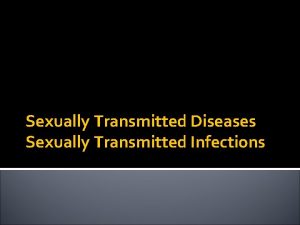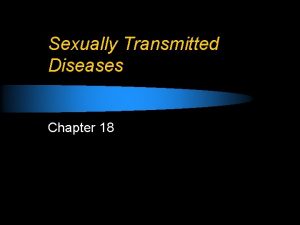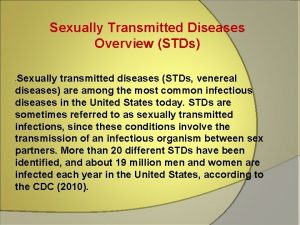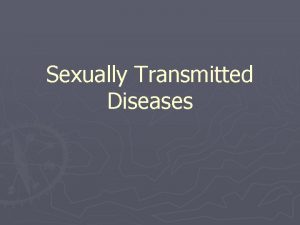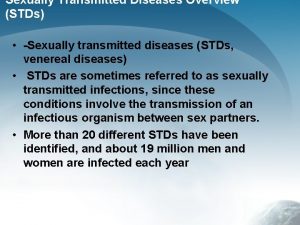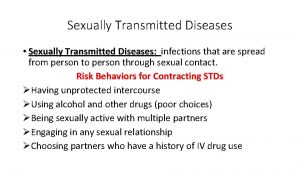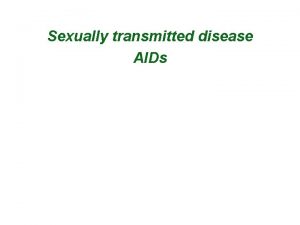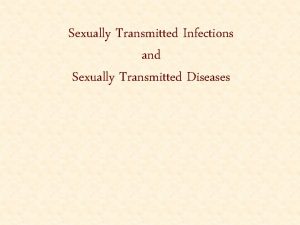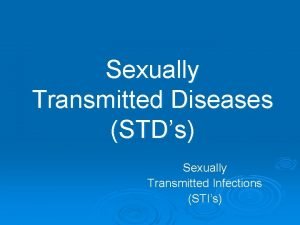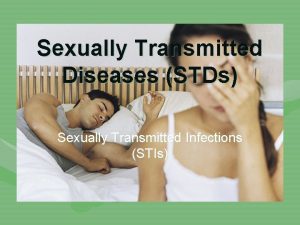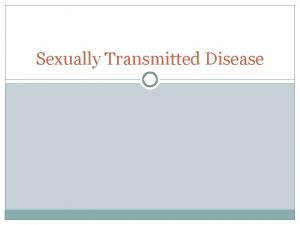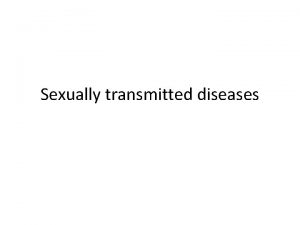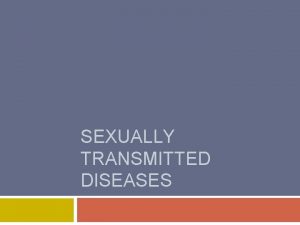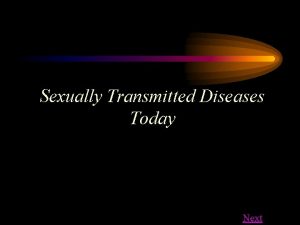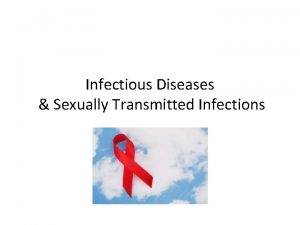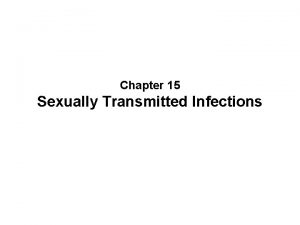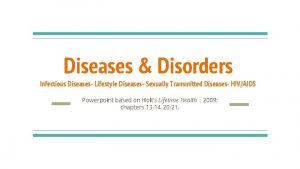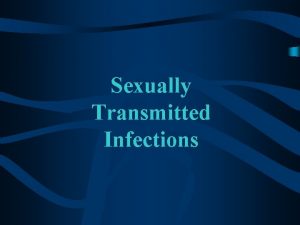Chapter 5 Sexually Transmitted and Sexually Related Diseases



















































- Slides: 51

Chapter 5 Sexually Transmitted and Sexually Related Diseases For use with the text, Human Sexuality Today, 5 th edition. Bruce M. King Slides by Callista Lee 1 King, Human Sexuality Today, 5/e (c) 2005 by Prentice Hall

What are they and who gets them? l l 2 The U. S. has the highest rate of STDs of any industrialized nation. 1 in 4 sexually active teens will contract at least one of these diseases: – Chlamydia – Gonorrhea – Hepatitis B – HIV King, Human Sexuality Today, 5/e (c) 2005 by Prentice Hall

Cause vs. transmission l STDs are caused by – – – l 3 Bacteria – curable with antibiotic treatment Parasites – curable with appropriate medication Viruses – treatable but not curable; one must learn to live with the disease Because these organisms like to live in or on our genitals they are rarely transmitted to others except by intimate, sexual contact. King, Human Sexuality Today, 5/e (c) 2005 by Prentice Hall

Promiscuity or bad luck? l l 4 Previously referred to as venereal diseases (related to the goddess of love, Venus), now called sexually transmitted diseases (STDs) or sexually transmitted infections (STIs). Innocent newborns, people who are in love but ignorant about the risks, faithful partners of infected persons, and first-time lovers of infected partners can become infected. King, Human Sexuality Today, 5/e (c) 2005 by Prentice Hall

Gonorrhea – Incidence and symptoms l l l 5 Bacterial - 650, 000 new cases yearly Can infect urethra, vagina, rectum, mouth, throat and/or eyes (warm mucous membranes) 5 – 20% of infected men are asymptomatic 60 – 80% of infected women are asymptomatic Thick, painful, pus-like white or yellowish discharge begins 2 – 10 days after infection Burning pain during urination King, Human Sexuality Today, 5/e (c) 2005 by Prentice Hall

Gonorrhea – Damage if not treated l l 6 In men, inflammation and permanent damage of the internal reproductive system and bladder In women, inflammation of internal reproductive system (Pelvic Inflammatory Disease) – sterility and tubal pregnancies 1 – 2% of cases move into the joints, skin, heart and brain covering Babies infected at birth may suffer blindness King, Human Sexuality Today, 5/e (c) 2005 by Prentice Hall

Pelvic Inflammatory Disease (PID) l l 7 20 – 40% of women infected with gonorrhea or chlamydia but not diagnosed and treated, will develop PID – 1 million cases yearly 1 in 7 women of reproductive age has PID Tenderness or pain in the lower abdomen, high fever, chills if symptomatic Sterility and/or life-threatening infection can occur if not treated aggressively King, Human Sexuality Today, 5/e (c) 2005 by Prentice Hall

Chlamydia – Incidence and symptoms l l l 8 Bacterial – at least 4, 000 yearly Symptoms similar to gonorrhea, but milder Irritation and burning of the urethra Discharge tends to be clear and thin rather than pus-like Especially prevalent in teens and young adults and very commonly asymptomatic King, Human Sexuality Today, 5/e (c) 2005 by Prentice Hall

Chlamydia – Damage if not treated l l 9 In men, infection of the prostate and epididymis and possible sterility In women, pelvic inflammatory disease A single attack of chlamydia is 3 times more likely than gonorrhea to result in sterility in women Increase in stillbirths, premature deliveries, and blindness in newborns King, Human Sexuality Today, 5/e (c) 2005 by Prentice Hall

Syphilis – Incidence and symptoms l l l 10 Bacterial – less than 10, 000 new cases yearly Primary stage – ulcerlike chancre sore at site of infection; disappears in 10 – 14 days Secondary stage – itchless, painless rash all over the body 4 – 6 weeks after the chancre has healed. Large, oozing sores may appear on the genitals. Other symptoms may include sore throat, low fever, nausea, aches and pains King, Human Sexuality Today, 5/e (c) 2005 by Prentice Hall

Syphilis – Later symptoms and damage l l 11 Latent stage – after about a year the disease is no longer contagious but internal organs (heart, blood vessels, brain, spinal cord) are being attacked by the bacteria. Late (tertiary) stage – about 1/3 will experience more serious, potentially fatal organ damage , large ulcers on skin and bones, paralysis, deafness, insanity. King, Human Sexuality Today, 5/e (c) 2005 by Prentice Hall

Congenital Syphilis l l l 12 The spirochete can travel through the placenta to the fetus, leading to miscarriage, stillbirth, or a baby born with “congenital syphilis. ” Complications include deformed bones and teeth, blindness, deafness and organ abnormalities that can result in early death. Babies can be treated with antibiotics to stop further damage; earlier damage is permanent. King, Human Sexuality Today, 5/e (c) 2005 by Prentice Hall

Bacterial Vaginitis l l 13 More common than the common yeast infection Also known as haemophilus, Gardnerella or nonspecific vaginitis It is probably not sexually transmitted, but rather from bacteria in the rectum/anus Foul, fishy-smelling, grayish vaginal discharge King, Human Sexuality Today, 5/e (c) 2005 by Prentice Hall

Cystitis and Prostatitis l l l 14 Neither is considered a sexually transmitted disease, although sexual activity will assist the bacteria in moving into vulnerable sites. Cystitis – Infection of the urethra; pain during urination and lower abdominal pain. Curable with antibiotics or sulfa drugs. Prostatitis – Infection of the prostate; pain in lower back or groin, fever, burning during ejaculation. Curable with antibiotics. King, Human Sexuality Today, 5/e (c) 2005 by Prentice Hall

Less common bacterial STDs l l l 15 Chancroid – painful chancre, swollen lymph nodes in the groin Granuloma inguinale – more common in tropical areas; painless pimple that ulcerates and spreads, killing tissue, fatal if untreated Shigellosis – from exposure to infected feces; acute diarrhea, fever, pain King, Human Sexuality Today, 5/e (c) 2005 by Prentice Hall

Herpes – Incidence l l l Oral Herpes – 2/3 of Americans have it; always assume that a fever blister or cold sore on or around the mouth is a herpetic infection Genital Herpes – 1, 000 new cases yearly Total Americans living with genital herpes = 50, 000, which is 1 in 5 – l 16 Because this is a viral infection it is not curable. Both HSV-1 and HSV-2 can infect the genitals King, Human Sexuality Today, 5/e (c) 2005 by Prentice Hall

Herpes – Transmission l l 17 Skin-to-skin contact, but also be wary of shared eating/drinking items with oral herpes “Autoinoculation” from one site to another Transmission during an outbreak (until the site is completely healed and normal looking) or in the “prodromal” period just prior to an outbreak Asymptomatic virus shedders King, Human Sexuality Today, 5/e (c) 2005 by Prentice Hall

Herpes – Primary attack (16 days) l Prodromal stage, 2 – 20 days after contact – – l l 18 Tingling, itching, or burning at the site of infection Pain running down the buttocks or thighs Then a rash, followed by very painful, fluid-filled blisters that will break open into running sores, which will eventually crust over Flu-like symptoms, aches, fever, swollen lymph glands, pain during urination (for genital cases) King, Human Sexuality Today, 5/e (c) 2005 by Prentice Hall

Herpes – Recurrent attacks l l l 19 About 1/3 never have another attack About 1/3 have occasional attacks About 1/3 suffer regular, recurrent attacks Recurrent attacks are generally less severe and only 5 – 10 days; be aware of prodromal symptoms to protect yourself and your partner HSV lies dormant in nerve cell ganglia King, Human Sexuality Today, 5/e (c) 2005 by Prentice Hall

Herpes – Serious complications l l l 20 Ocular herpes – blindness Increases the risk of human papillomavirus (HPV) of the cervix becoming cancerous Herpes encephalitis (brain/spinal cord) Increased risk of miscarriage, premature birth, congenital malformations Neonatal herpes – severe neurological problems and death King, Human Sexuality Today, 5/e (c) 2005 by Prentice Hall

Herpes – Treatment and prevention l l l l 21 Allow the outbreak area to dry OTC and Rx anti-viral medications Avoid direct contact & shared personal items Avoid physical and emotional stress (and sunlight for oral herpes) Condoms and honest communication A diagnostic blood test is now available A preventive vaccine will be available soon King, Human Sexuality Today, 5/e (c) 2005 by Prentice Hall

Hepatitis – Like the flu x 10 l l l 22 Hepatitis B (serum hepatitis) – 120, 000 new cases yearly, transmitted sexually or via infected blood or saliva Hepatitis A (infectious hepatitis) – numbers dropping due to vaccines, transmitted via sexual contact, food handled by infected persons, or shellfish from infected waters Hepatitis C – usually from infected blood, leads to liver failure and death King, Human Sexuality Today, 5/e (c) 2005 by Prentice Hall

HPV – Genital Warts Human Papillomaviruses l l 5, 500, 000 new cases every year in the U. S. 80% of HPV infections disappear on their own. – l l 23 Our immune system is sometimes able to combat it. If HPV results in visible genital warts, they will appear anytime from 3 weeks to 8 months after contact with an infected person and may cause itching, irritation and even bleeding. Nearly all women with cervical cancer have HPV, and have no visible symptoms King, Human Sexuality Today, 5/e (c) 2005 by Prentice Hall

HPV – Treatment and prevention l l Injectable, antiviral drugs show promise Visible warts must be removed – l l l 24 Chemical drying/burning/freezing or minor surgery A vaccine is on the way Condoms will prevent some cases, depending on the site of the HPV on the infected person 80% of infected women’s partners show no visible symptoms King, Human Sexuality Today, 5/e (c) 2005 by Prentice Hall

Molluscum Contagiosum l l 25 Painless dome-shaped growths caused by a pox virus, spread by skin-to-skin contact 100, 000 new cases yearly but this usually disappears on its own without treatment If the growths are large, numerous, or just don’t go away they can be removed by a physician No harm, just ugly King, Human Sexuality Today, 5/e (c) 2005 by Prentice Hall

HIV – Human Immunodeficiency Virus l l l 26 Although HIV has been around for quite some time, it was not identified until 1984. HIV is a retrovirus; it attaches to healthy immune system cells and reverses their normal pattern of cell reproduction, destroying the cell and creating new copies of itself. HIV, if not stopped, eventually leads to a condition now known as AIDS. King, Human Sexuality Today, 5/e (c) 2005 by Prentice Hall

HIV – Replication HIV invades the host’s CD 4+ lymphocytes (also called Helper T cells and T 4 lymphocytes); important immune system cells. 27 King, Human Sexuality Today, 5/e (c) 2005 by Prentice Hall

HIV and the immune system l l l 28 The immune system defends against bacteria, viruses, fungi, and cancerous cells. White blood cells (lymphocytes) are the main line of defense in the immune system. When the immune system is compromised (as is the case with HIV infection), the person easily becomes a victim to infections that healthy persons would be able to “fight off. ” King, Human Sexuality Today, 5/e (c) 2005 by Prentice Hall

HIV – Early stages of infection l l l 29 Within 24 hours of receiving infected fluids into the bloodstream, the person can infect others. Primary HIV infection – about two weeks after infection, flu-like symptoms lasting several weeks (in 50 – 75% of those infected); signifies the immune system’s attack on HIV invaders. Asymptomatic HIV infection – person appears healthy; often lasts several years. King, Human Sexuality Today, 5/e (c) 2005 by Prentice Hall

HIV – From HIV to AIDS l Symptomatic HIV infection – CD 4+ levels fall below 500 (normal = 1000 - 1200); headaches, lost appetite diarrhea, low-grade fever, night sweats, swollen lymph nodes, colds, flu, and yeast infections that linger despite treatment. – l 30 About half reach this stage within 2 years AIDS (Acquired Immunodeficiency Syndrome) – CD 4+ level below 200; life-threatening “opportunistic infections” King, Human Sexuality Today, 5/e (c) 2005 by Prentice Hall

HIV – Will everyone infected get AIDS? l l 31 50% develop AIDS within 5 years 12% have not yet developed AIDS after 20 yrs. 2 – 4% are “long-term nonprogressors” and maintain normal CD 4+ levels, and are without symptoms even without treatment. Today’s drug therapies slow the progression of HIV to AIDS in large numbers of patients. King, Human Sexuality Today, 5/e (c) 2005 by Prentice Hall

HIV and AIDS – A worldwide problem 32 King, Human Sexuality Today, 5/e (c) 2005 by Prentice Hall

HIV – Where did it originate? l l l 33 Recent studies have definitively established that this virus was transmitted to humans from chimpanzees and other primates eaten in Africa. No conspiracy theories have held up. Use of nonsterilized needles for injections and vaccinations may have helped to spread HIV from person to person. HIV was already starting to spread in 1959. King, Human Sexuality Today, 5/e (c) 2005 by Prentice Hall

HIV – Human transmission l l l Infectious fluids must include CD 4+ cells: blood, semen, vaginal fluids, breast milk, and fluids surrounding joints and the brain. Other bodily fluids are not infectious unless infected blood has crept into them; saliva actually blocks HIV from infecting human cells. HIV is transmitted almost exclusively by intimate sexual contact or contaminated blood. – 34 All donated blood in the U. S. is tested for HIV. King, Human Sexuality Today, 5/e (c) 2005 by Prentice Hall

HIV – Why sex is risky l l l 35 Infected semen or vaginal fluids have an opportunity to seep through porous mucus membranes or small tears in the skin to enter the bloodstream. Receiving infected sexual fluids into your body is riskier than having those fluids on your body. Most risky: anal intercourse High risk: vaginal intercourse Low risk: oral-genital sex King, Human Sexuality Today, 5/e (c) 2005 by Prentice Hall

HIV – From mother to baby l l Only 20 – 25% of babies born to HIV+ mothers will become infected at birth; with anti-viral treatment during pregnancy and cesarean birth, the risk is reduced to 2%. 16% of babies will become infected by breastfeeding; the United Nations recommends that women with HIV not breastfeed their babies. – 36 Baby formula is often not available to poor women. King, Human Sexuality Today, 5/e (c) 2005 by Prentice Hall

AIDS – Who has it? Worldwide, 14, 000 new infections daily; 34 – 40 million living with HIV; 3 million die of AIDS each year. 37 King, Human Sexuality Today, 5/e (c) 2005 by Prentice Hall

HIV and AIDS – In developing countries l l l 38 90% of persons infected with HIV live in developing countries. Two-thirds are in sub. Saharan Africa where HIV originated. Uganda, Zambia and Rwanda have already been devastated; in some places more than 1 of 3 people are infected, HIV is spreading in Southeast Asia, India and China in frightening proportions. King, Human Sexuality Today, 5/e (c) 2005 by Prentice Hall

HIV and AIDS – In the United States l l l 39 40, 000 new HIV infections and 45, 000 new AIDS diagnoses each year AIDS is the leading cause of death among Americans aged 25 – 44, ahead of accidents, cancer and heart disease. HIV is spreading most quickly among African Americans and Latinos, especially females, who tend to not see themselves as “at risk. ” King, Human Sexuality Today, 5/e (c) 2005 by Prentice Hall

AIDS – Wasn’t this a “gay disease? ” l l Worldwide, the vast majority of cases are among heterosexuals. HIV spread quickly among the U. S. gay population for these reasons: – – 40 Of people infected in the early years (1970 s and 1980 s), many were promiscuous gay men who engaged in high risk sexual behaviors. HIV had already been spread to tens of thousands of gay men before anyone knew about HIV or AIDS. King, Human Sexuality Today, 5/e (c) 2005 by Prentice Hall

The human side of HIV and AIDS l l 41 The likelihood of knowing someone who is either infected or who is close to someone who is infected is high. Severe depression and suicide rates of infected persons is very high. Stressful life events and lifestyles can speed the progression of HIV to AIDS. Infected persons need positive support King, Human Sexuality Today, 5/e (c) 2005 by Prentice Hall

HIV testing l l l 42 Tests identify the presence of antibodies to HIV in blood, saliva or urine. Antibodies to HIV generally develop between 2 – 6 months in most infected persons, but some people take longer to “seroconvert. ” A positive ELISA test result will be confirmed with the Western Blot blood test or IFA (immunofluourescent assay) which are more expensive. King, Human Sexuality Today, 5/e (c) 2005 by Prentice Hall

Treatment for HIV and AIDS l l Antiretroviral drug therapy does not cure AIDS. The 3 -drug (26 pills a day) “AIDS Cocktail” can knock down HIV levels and partially restore immune responses. – – 43 Side effects can be worse than the disease Patients must adhere to a strict schedule Numbers of drug resistant cases growing quickly These medications are very expensive King, Human Sexuality Today, 5/e (c) 2005 by Prentice Hall

HIV/AIDS – Attitudes and behaviors l l l 44 Communication: Over 70% of HIV infected individuals report that they do not reveal their infection status to new casual sex partners. Without a vaccine, prevention through a change of sexual behaviors is our only hope. Programs that stress condom usage have been more effective than programs stressing abstinence or a reduction in number of sexual partners. King, Human Sexuality Today, 5/e (c) 2005 by Prentice Hall

Parasites – Crabs, Scabies and Pinworms l Crabs (public lice) – intense itching – – l Scabies (mites) – intense itching – – l Easily transmitted, skin-to-skin, clothing, linens, etc. OTC medication applied to body, clothing, linens… Pinworms – live in large intestine – 45 Usually sexually transmitted OTC medication applied to affected body parts, clothing and linens oral/anal sexual transmission in adults King, Human Sexuality Today, 5/e (c) 2005 by Prentice Hall

Vaginitis – Most women will experience it l l Hormonal imbalances, allergies, chemical irritations and infection cause vaginitis Trichomoniasis (parasitic) – 5, 000 new cases each year; treated with Rx medication. – – 46 Lots of foamy, yellowish-green discharge, foul odor, and intense vaginal itching in the 50% of women who are symptomatic. Male partners are usually asymptomatic. Usually sexually transmitted but it can survive on damp towels or a wet toilet seat. King, Human Sexuality Today, 5/e (c) 2005 by Prentice Hall

Vaginitis – The common “yeast” infection l Moniliasis or Candidiasis or “Yeast” (fungal parasite common in the vagina, groin & throat) – – – 47 ¾ of women will experience a yeast infection at some point in their lives; 10 – 20% have recurrent (4 or more a year) episodes Sometimes sexually transmitted but most infections are simply overgrowths due to hormone changes, diabetes, douches, or use of antibiotics “Jock Itch” in men and “Thrush” in the throat King, Human Sexuality Today, 5/e (c) 2005 by Prentice Hall

Avoiding Vaginitis l Whether it is bacterial or parasitic, vaginitis can often be avoided by: – – – 48 Avoiding deodorant soaps and feminine hygiene sprays and douches Drying the vulva thoroughly after bathing and wearing cotton panties rather than synthetic fabrics Adequate vaginal lubrication for sexual intercourse Keeping stress to a minimum Use condoms and never have vaginal penetration after anal penetration King, Human Sexuality Today, 5/e (c) 2005 by Prentice Hall

Safer Sex – Minimizing the risk of STDs l l Mutually faithful, long-term, monogamy Testing for the common STDs prior to sexual activity with a new partner Avoid use of alcohol/drugs when making sexual decisions – communicate clearly Always use a condom & water-based lubricant – – 49 Using condoms is smart, mature, and caring Learn how to use condoms correctly; avoiding breakage and improving pleasure King, Human Sexuality Today, 5/e (c) 2005 by Prentice Hall

Are you at risk? 1 in 4 American teenagers l l Multiple sexual partners? Exchange of sexual fluids? Decisions clouded by drugs or alcohol? Have you both been tested for STDs recently? – l l 50 HIV tests only for HIV; Pap tests only test for cancer Ability to discuss STD risks and pregnancy? Have you or your partner ever had unprotected sex? King, Human Sexuality Today, 5/e (c) 2005 by Prentice Hall

Sex doesn’t cause STDs l l 51 Bacteria, viruses and parasites cause STDs, but sexual activities can transmit them from one person to another. Condoms, used correctly, every time can dramatically reduce risk of STD transmission. You are responsible for the level of risk in your sexual behaviors; own your decisions. Be “sex positive” – be safe! King, Human Sexuality Today, 5/e (c) 2005 by Prentice Hall
 Chapter 24 sexually transmitted diseases and hiv/aids
Chapter 24 sexually transmitted diseases and hiv/aids Chapter 24 lesson 1 sexually transmitted diseases
Chapter 24 lesson 1 sexually transmitted diseases Sexually transmitted diseases
Sexually transmitted diseases Nursing management of reproductive tract infection
Nursing management of reproductive tract infection Chapter 25 sexually transmitted infections and hiv/aids
Chapter 25 sexually transmitted infections and hiv/aids Std
Std Iceberg phenomenon
Iceberg phenomenon Two types of physical fitness
Two types of physical fitness Skill related fitness
Skill related fitness Retention hyperkeratosis dermnet
Retention hyperkeratosis dermnet Chapter 6 musculoskeletal system
Chapter 6 musculoskeletal system Chapter 22 genetics and genetically linked diseases
Chapter 22 genetics and genetically linked diseases Chapter 21 mental health diseases and disorders
Chapter 21 mental health diseases and disorders Chapter 17 reproductive system diseases and disorders
Chapter 17 reproductive system diseases and disorders Chapter 15 nervous system diseases and disorders
Chapter 15 nervous system diseases and disorders Seborrheic keratoses
Seborrheic keratoses Nail disease
Nail disease Onychomycosis milady
Onychomycosis milady Chapter 8 cardiovascular system
Chapter 8 cardiovascular system Milady chapter 8 skin disorders and diseases
Milady chapter 8 skin disorders and diseases 10 diseases of lymphatic system
10 diseases of lymphatic system Spongia drawing
Spongia drawing Chapter 32 childhood communicable diseases bioterrorism
Chapter 32 childhood communicable diseases bioterrorism Chapter 23 lesson 2 common communicable diseases
Chapter 23 lesson 2 common communicable diseases Chapter 23 lesson 1 understanding communicable diseases
Chapter 23 lesson 1 understanding communicable diseases Transmitted light examination in questioned document
Transmitted light examination in questioned document A song transmitted orally which tells a story
A song transmitted orally which tells a story According to uniform wear theory
According to uniform wear theory Electronically transmitted postal ballot system
Electronically transmitted postal ballot system The totality of learned socially transmitted behavior
The totality of learned socially transmitted behavior Whale phylum
Whale phylum Do worms reproduce sexually or asexually
Do worms reproduce sexually or asexually Invertebrates characteristics
Invertebrates characteristics Unokais
Unokais Rules of consent
Rules of consent Protoctista reproduction
Protoctista reproduction Was it sexual abuse quiz
Was it sexual abuse quiz Oral surface of brittle star
Oral surface of brittle star Animal like protists
Animal like protists Vasocongestion definition
Vasocongestion definition Do worms reproduce sexually or asexually
Do worms reproduce sexually or asexually Have i been sexually harassed quiz
Have i been sexually harassed quiz Sexual propagation
Sexual propagation Cnidaria class
Cnidaria class Bilateral symmetry
Bilateral symmetry Freight
Freight How birds reproduce sexually
How birds reproduce sexually Sexually dimorphic meaning
Sexually dimorphic meaning Illinois sex offender management board
Illinois sex offender management board Modern lifestyle and hypokinetic diseases
Modern lifestyle and hypokinetic diseases Venn diagram of communicable and non-communicable diseases
Venn diagram of communicable and non-communicable diseases Section 19-3 diseases caused by bacteria and viruses
Section 19-3 diseases caused by bacteria and viruses





